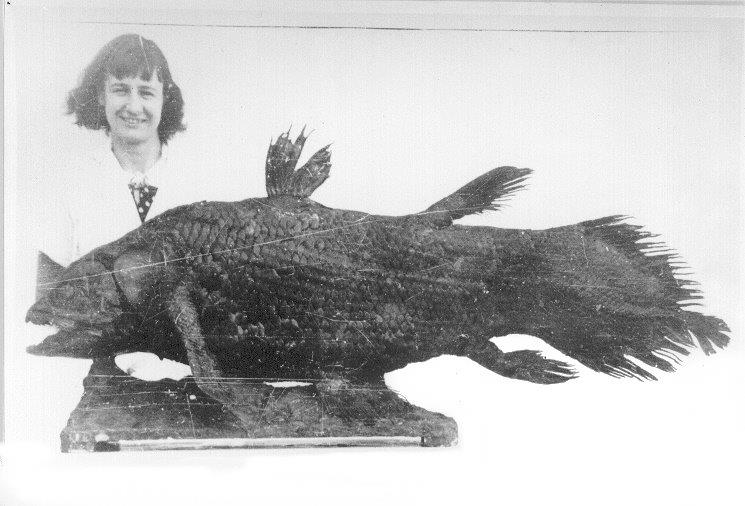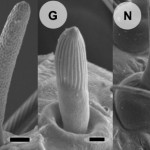The term “living fossil” carries far more weight than Grandpa’s 80th birthday card. The world is supposedly full of animals, plants, even bacteria that—depending on who you ask—have barely evolved in millions of years. Alligators, sharks, gingko trees all bear the label. Their poster child is the coelacanth, the last living member of a subclass of fish called Actinista. But the so-called greatest fish story of all time might have had more to do with the “living fossil” label than it’s given credit for.
Scientists thought coelacanths were extinct for more than 65 million years until a fisherman caught one in his trawl in December of 1938 off the coast of South Africa. A local museum curator, Marjorie Courtenay-Latimer, was working on puzzling together dinosaur bones when the phone rang. The captain of the ship, Narine, asked if she wanted to come and look through the day’s catch for any museum specimens.
Courtenay-Latimer hemmed and hawed before she decided to take the cab down to the docks. But she soon laid her eyes on the 5-foot-long, 127 pound fish. After a brief quarrel, she convinced the taxi driver to take her back to the museum with the fish. She knew the fish was an exciting find but couldn’t identify it. She carted the fish through the streets of East London looking for someone to help her preserve it. Eventually she wound up at a taxidermist where they wrapped it in newspaper soaked in one liter of formalin, barely enough to keep the outside preserved.
Courtenay-Latimer contacted the chemist-turned-biologist, James Leonard Brierly Smith, but her message took quite a while to reach him since he was on vacation. When he saw her drawings he was struck by the similarity they had to 65 million-year-old coelacanth fossils. However, it was too late before his message to preserve the soft insides of the fish reached Courtenay-Latimer. The fish was already decomposing, and Courtenay-Latimer had little choice but to toss out the inner organs and skeleton of the fish in order to preserve the outer body, which the taxidermist stuffed like a museum mount.

Courtenay-Latimer with the stuffed coelacanth. Via wikimedia commons.
Smith eventually made his way to Courtenay-Latimer in East London, South Africa to identify the animal. The press had already caught wind of the discovery. Smith negotiated that only one local paper could report the story before he had a chance to publish his findings in a scientific journal. Nevertheless, papers across the globe quickly published stories on the “missing link” between aquatic and terrestrial animals. Smith himself supported this conjecture. He often referred to the fish as “primitive” and as being under evolved. From then on, the label “living fossil” was practically set in stone for the fish.
For scientists, the concept of a living fossil, especially one that was playing hide-and-seek with us for so long, is beguiling if not farfetched.
Considering the history of the coelacanth, it makes sense that generations of scientists, subconsciously or not, would have a vested interest in proving that the coelacanth is indeed a living fossil.
The scientific literature abounds on the coelacanth’s relatively unchanged morphology and “slowly evolving” genome. To be clear, no one is saying the coelacanth has not evolved at all in the last 65 million years. Some scientists just believe that it has evolved more slowly, while other think that assumption is dangerous if not outright absurd.
When approached with the living fossil debate, many evolutionary biologists roll their eyes with a “not this again” sigh. The naysayers are too focused on semantics, according to Giacomo Bernardi at the Long Marine Lab in Santa Cruz, California.
Bernardi pointed out that when the coelacanth genome was sequenced earlier this year, the study found that some parts of the genome were evolving more slowly while others were evolving at a normal rate.
“It’s an organism that basically hasn’t undergone that much in the way of morphological change over time, and that it’s one of the only representatives of a very ancient lineage,” said Chris Amemiya, lead author on the study that sequenced the coelacanth genome. Amemiya sees the term “living fossil” as a shorthand.
On the other side of the fence, biologist Patrick Laurenti thinks there are more than just words at play.
In the paper, “Why Coelacanths are not ‘living fossils,’” Laurenti and his co-author Dider Casane present conflicting data on the matter. On the one hand, some very influential papers find that genes that influence body structure are highly unchanged in the coelacanth. But Casane and Laurenti go on to describe several more studies that didn’t find anything remarkable about the evolution rate in the same genes.
Laurenti and Casane suggest that perhaps the conflicting conclusions of these papers lie in the use of the term, “living fossil.” In papers where the authors simply accepted that coelacanths are slowly evolving or otherwise unchanged, they found evidence for a low substitution rate in the fish’s genes. But studies that questioned if coelacanths are living fossils found normal substitution rates.
It’s extremely difficult to study the coelacanth. It lives in an isolated, hard-to-get-to environment. Smith identified the fish shortly before World War II broke out which distracted research for many years. Smith was finally able to obtain another specimen off the islands of Comoros in 1952.
Coelacanths are also protected, so scientists can only study their tissues in the lab when fishermen catch the animals accidentally. Needless to say, research on the animals has been slow going since 1938.
A couple of recent papers published in the Journal of Experimental Zoology show that some researchers are starting to consider Laurenti and Casane’s point of view. It seems that perhaps some researchers are beginning to wonder if perhaps their interpretation of the data was influenced by bias. It’s an exciting moment – one that might signal the beginning of a paradigm shift.







Nice article Cynthia. Thanks for writing it. I wouldn’t necessarily say we’re on the other side of the fence. Laurenti and Casane raise some good points and it is difficult to reconcile the slow molecular evolution of the coelacanth’s genome with its morphology.
Nice article indeed!. I do agree with Chris Amemiya, we’re not on opposite sides of the fence: the debate focuses on a minor point of a major paper!